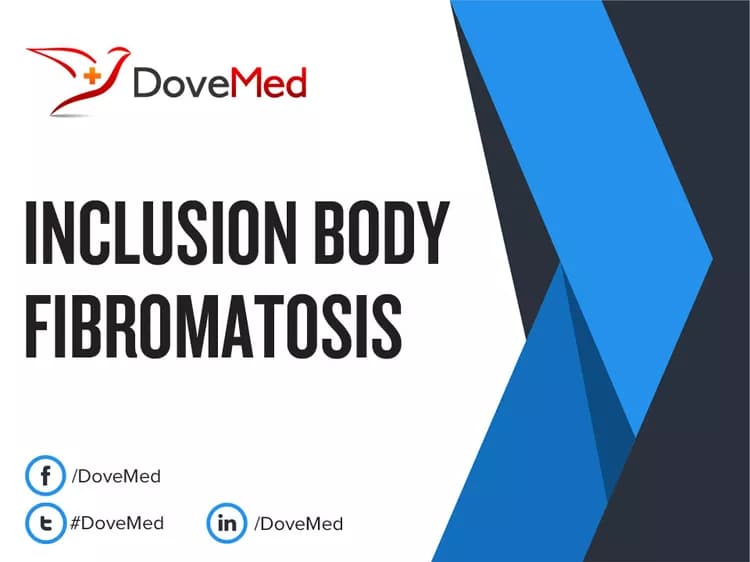What are the other Names for this Condition? (Also known as/Synonyms)
- Infantile Digital Fibromatosis (IDF)
- Multiple Hyaline Fibromatosis
- Reye's Tumor
What is Inclusion Body Fibromatosis? (Definition/Background Information)
- Inclusion Body Fibromatosis (IBF) is a rare, benign tumor of specific types of cells in the body, called fibroblasts and myofibroblasts
- The tumor is usually found on the toes and fingers; more than one toe or finger may be involved. However, IBF is rarely found on the thumb or the big toe. Other affected regions include the forearm, arm, and breast
- Inclusion Body Fibromatosis is characterized by the presence of inclusion bodies (abnormal structures found in cells having certain specific staining properties). In spite of a suggestive ‘tumor’ name, inclusion bodies (when examined by a pathologist under a microscope) are found in only a minority of the tumor cells
Who gets Inclusion Body Fibromatosis? (Age and Sex Distribution)
- Inclusion Body Fibromatosis is usually found in young children, in the first year of their birth
- Both male and female are affected by the condition with equal frequency
What are the Risk Factors for Inclusion Body Fibromatosis? (Predisposing Factors)
- Currently there are no documented risk factors for the development of Inclusion Body Fibromatosis
It is important to note that having a risk factor does not mean that one will get the condition. A risk factor increases ones chances of getting a condition compared to an individual without the risk factors. Some risk factors are more important than others.
Also, not having a risk factor does not mean that an individual will not get the condition. It is always important to discuss the effect of risk factors with your healthcare provider.
What are the Causes of Inclusion Body Fibromatosis? (Etiology)
The cause of Inclusion Body Fibromatosis is presently unknown.
What are the Signs and Symptoms of Inclusion Body Fibromatosis?
The signs and symptoms of Inclusion Body Fibromatosis include:
- This tumor is usually found as a firm swelling in the toes and fingers of young children (generally before age 1 year)
- The majority of tumors are less than 2 cm (along the greater dimension)
- The skin over the tumor is stretched, shiny, and is not usually discolored. In rare cases, the skin may have a reddish-brown to dark brown discoloration
- The tumor is typically found on the toes and fingers; more than one toe or finger may be involved
- However, IBF is rarely found on the thumb or the big toe. Other affected regions reported include the forearm, arm, and breast
How is Inclusion Body Fibromatosis Diagnosed?
The following methods are adopted to diagnose Inclusion Body Fibromatosis:
- A thorough physical examination and a complete medical history
- Tissue biopsy; which is examined by a pathologist under a microscope
- X-ray of the affected toes or fingers is performed to help rule out the possibility of the tumor invading into the underlying bone
- MRI scans of the toe or finger will help reveal the tumor presence and the extent of its growth
- Occasionally, electron microscopic special studies may have to be performed to arrive at a definitive diagnosis
Many clinical conditions may have similar signs and symptoms. Your healthcare provider may perform additional tests to rule out other clinical conditions to arrive at a definitive diagnosis.
What are the possible Complications of Inclusion Body Fibromatosis?
The possible complications of Inclusion Body Fibromatosis include the following:
- Involvement of the underlying bones, which makes a surgical excision difficult
- Recurrence of the tumor after surgical excision that is observed in over half of the cases. If a complete excision of the tumor is achieved, then the prognosis is generally excellent
How is Inclusion Body Fibromatosis Treated?
The following treatment measures are adopted to treat Inclusion Body Fibromatosis:
- The treatment of the tumor is by surgical excision. Complete excision and tumor removal should be performed, if possible. This decreases the chances of tumor recurrence
- While performing the surgical excision, the surgeon ensures that the function of the toes and fingers are kept intact to the extent possible
- At times, it is difficult to perform the surgical procedure without affecting the function of the finger or toe. If the tumor involves the underlying bone, then amputation of the affected toes and fingers may be sometimes considered by the surgeon
- Tumors occurring in other regions, such as the forearm or breast, are also treated through surgical excision
How can Inclusion Body Fibromatosis be Prevented?
Currently there are no methods to prevent the development of Inclusion Body Fibromatosis.
What is the Prognosis of Inclusion Body Fibromatosis? (Outcomes/Resolutions)
- Inclusion Body Fibromatosis tumor does not metastasize to other parts of the body. It is a benign tumor
- If complete surgical excision and removal of tumor is achieved, then the prognosis for a child with the tumor is excellent
Additional and Relevant Useful Information for Inclusion Body Fibromatosis:
- A pathologist may perform additional (special) studies to arrive at a definitive diagnosis, which include immunohistochemical stains
- Inclusion Body Fibromatosis (IBF) is positive for vimentin and muscle actin immunohistochemical stains. The tumor is negative for pancytokeratin immunohistochemical stain
- As the tumor name suggests, IBF may have inclusion bodies within cells that consists of round pink inclusions within the cell cytoplasm. These are positive for a histochemical stain called trichrome stain and negative for a histochemical stain called PAS stain
Related Articles
Test Your Knowledge
Asked by users
Related Centers
Related Specialties
Related Physicians
Related Procedures
Related Resources
Join DoveHubs
and connect with fellow professionals



0 Comments
Please log in to post a comment.